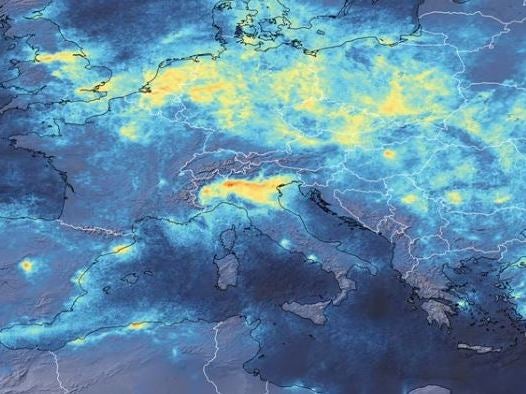This website uses cookies so that we can provide you with the best user experience possible. Cookie information is stored in your browser and performs functions such as recognising you when you return to our website and helping our team to understand which sections of the website you find most interesting and useful.

Air pollution over northern Italy has fallen sharply after the coronavirus forced the country into a nationwide lockdown, satellite imagery has revealed.
The images are another striking example of how the pandemic has cut greenhouse gas emissions from human activity, after the same effect was seen in China, where the outbreak started.
The European Space Agency (ESA) timelapse video taken from above the Earth, which runs from the start of the year until this week, shows a marked drop in emissions of nitrogen dioxide, a noxious gas emitted by power plants, cars and factories, over northern Italy.
“Although there could be slight variations in the data due to cloud cover and changing weather, we are very confident that the reduction in emissions that we can see coincides with the lockdown in Italy causing less traffic and industrial activities,” said Claus Zehner, who manages the Copernicus Sentinel-5P, the satellite which took the photos over the Po Valley region.
Italy, which has had the biggest outbreak of coronavirus in the west, has now had 17,660 confirmed coronavirus cases, with 1,266 deaths, and the government has imposed the most severe controls placed on a western nation since the Second World War.
The first lockdowns of society in the north of the country began around 22 February, when normal activities were suspended in 11 towns. Schools, universities and tourist attractions closed.
Two weeks later, Italian prime minister Giuseppe Conte announced the expansion of the quarantine zone to cover much of northern Italy, affecting at least 16 million people, restricting travel from, to or within the affected areas, and banning cultural events.
Many offices closed in Milan and airlines cancelled flights to northern Italy. Industry – from car plants to fashion manufacturers – shut factories.
Researchers studying the impact of greenhouse emissions on the climate crisis and human health are scrambling to understand the possible implications of the pandemic.
In China, experts said that in the four weeks to 1 March, carbon dioxide emissions fell by a quarter – an estimated 200m tonnes – which is about half the amount Britain emits in a year.
And similar satellite images over the country from Nasa also revealed drastic drops in nitrogen dioxide as people stayed at home and industry slowed or closed down.
Scientists found the coronavirus wiped out at least a quarter of China’s emissions of damaging greenhouse gases in just two weeks in mid-February.



 Africana55 Radio
Africana55 Radio 

